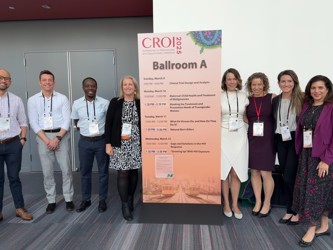Gilead Sees Success With HIV PrEP Trial In South Africa
A conversation with Moupali Das, MD, MPH, PrEP clinical program lead, Gilead Sciences

Many things about Gilead Sciences’ PURPOSE 1 trial for the prevention of HIV in adolescent girls and young women would give clinical researchers pause:
- It’s being conducted in sub-Saharan Africa, a place whose countries often have limited resources for clinical research.
- It includes teenagers, a population subset often requiring parental or guardian consent and considered by researchers as needing special protections.
- It is studying a preventive medication for HIV, a prevalent and also stigmatized disease.
Yet, none of those factors deterred Gilead Sciences’ PrEP Clinical Program Lead Moupali Das, MD, MPH and her HIV Clinical Development team.
More than five years ago, Dr. Das first discussed with Clinical Leader the company's intentions to study this new HIV prevention drug in Sub-Saharan Africa. Two years later, she shared an update. Now, in this Q&A, we catch up with Dr. Das to learn how she and her team navigated the above factors and successfully completed the Phase 3 trial showing similar pharmacokinetics in adolescents aged 16 and 17 years as in adults.
Clinical Leader: What do we know about HIV incidence and prevalence, especially in the adolescents?
Moupali Das: In the regions of the globe where HIV is the biggest problem in terms of new infections and burden of disease, young women and adolescent girls are disproportionately affected. Particularly in South Africa, by the time they are in their mid-30s, unfortunately, many women have already acquired HIV because of the intensity of the epidemic in that region. We chose to study lenacapavir’s efficacy in these regions because we wanted to understand how the drug worked in the face of overwhelming incidence.
Normally in pharmaceutical drug development, we study the situation in adults first to get safety and efficacy data, and then we go into younger populations. This has been done to protect adolescents from research. But the revolutionary thing about the PURPOSE 1 trial is we sought to protect adolescents through research. Instead of excluding adolescents, we first evaluated safety in adults and then, after the first 300 adults had been studied, we convened our independent data monitoring committee to evaluate the early safety data. Once they agreed that it appeared to be safe in adults, we proceeded to enroll adolescents.
When you decided to enroll adolescents, was that part of the same study or a new one?
We wrote into the study protocol — and the regulatory agencies, the ethics boards, and the investigators agreed — that after the first 300 adult participants, we would convene the independent data monitoring committee to review the data. If the data were acceptable to them, we would include adolescents. This way, we didn't have to go back to the regulatory agency and experience a delay because it often takes a while for regulators to review a protocol amendment; a protocol amendment has to go through ethics and institutional review boards again. We laid out the plan in advance such that we could proceed to enroll adolescents early.
Is that common practice?
In my experience, that's not common. It's the first time I've done that and I've been at Gilead almost 12 years. I do know that many regulatory agencies and doctors and people who take care of adolescents have advocated for including adolescents in adult trials, so we sought to do it in the safest, most ethical, most thoughtful, and most intentional way possible.
Historically, there have been varying degrees of stigma regarding HIV infection and transmission. Were there any societal attitudes toward HIV infection that you had to address or overcome while planning this trial?
We have progressed, but HIV stigma continues to exist even in the United States where we have ready access to multiple therapies for HIV treatment and prevention. Globally, it's a more intense situation because the burden of disease is higher. And there's still a lot of stigma associated with HIV in South Africa and Uganda where we conducted the PURPOSE 1 study.
So, we worked with investigators and site staff experienced in maintaining confidentiality and supporting potential participants. The sites reassured them about their privacy and confidentiality and also provided prevention education and education about reproductive health throughout the conduct of the trial. That also empowered some of these young people who wanted to raise awareness among their friend groups, communities, and families. But if they did not want to share that they're a participant in the clinical trial, they did not have to. This is another reason why twice-yearly subcutaneous lenacapavir could be a benefit.
In our qualitative, in-depth interviews with a subset of participants of PURPOSE 1, we found an upside to the injection over pills. In the trial, people are taking injections and pills because it is a randomized control trial. But in the future, a twice-a-year injection could mean that nobody will see the pill bottles on your bedside table or in your medicine cabinet or hear them clicking in your purse. In places like Uganda and South Africa, those things can reveal a medical status because it's relatively uncommon to be taking chronic medicines. If someone hears a pill bottle jingle, they assume you might have HIV.
We've also heard from investigators and community members who represent participants in PURPOSE 2, which took place in the United States as well as other places globally, HIV stigma is also a problem in parts of the American South and rural areas. That is one of the tremendous potential benefits of having a long-acting injectable; it addresses the stigma of having oral pills.
How then does a twice-yearly injection affect patient adherence?
We saw much higher adherence — over 90% — to the injectable and much lower adherence to the oral pills. We measured drug levels and learned that people did not adhere as well to the pills in the trial compared to coming back to the site for their injections.
Since this age group would require consent and/or assent for patients to enroll, was it tough to get parents and their kids talking together about a sensitive subject?
In these communities, we employed innovative strategies around ethical consent in adolescents. In certain locations, young people considered emancipated could consent for themselves, even if they were under 18. In Cape Town, South Africa, one investigator described the idea of community consent. There, the investigators overviewed the study with the community, and the community advisory groups gave community consent for the study to happen. In that situation, there could be a waiver of parental assent.
But all of these rules and regulations and laws are very different in different geographies. The age of maturity or legal consent varies by location, so we worked very closely with the sites and the staff and made sure the investigators had a lot of experience working with adolescent populations. We spent a lot of time intentionally thinking about site selection and recruitment. We wanted the sites to have their own engagement with the community, and that was a critical part of site selection. In this particular case, whether it's adolescents or pregnant women, we wanted the sites to have experience working with those populations.
We did it all during the early days of the pandemic, too, so we had a lot of Zoom engagement and investigator meetings. We have the standard procedure, which is a feasibility survey, but we added the step of meeting with the site staff and the investigators. And I was on every one of these calls because I wanted to understand what people were thinking about the trial. We drilled down into the feasibility survey, and we added questions to the standard feasibility survey to make sure we're complying with GCP, GLP, and GMP. We also added questions about their engagement with the community, their experience with adolescent medicine or with OB-GYN and pregnancy.
What are some lessons learned that apply to another trial or that others can learn from?
There's increasing recognition of the importance of including younger populations in parallel instead of sequentially. There are pros and cons of either approach, but a lot of it involves changing hearts and minds to protect people through research rather than from research. We also made sure that we have the right preclinical and early phase data to ensure this is a safe and effective trial by using the independent data monitoring committee, sometimes called a Data Safety Monitoring Board, to review a chunk of the adult population data early and help us make a thoughtful decision. This is a really good step forward to get data earlier in those populations that are disproportionately affected by HIV, especially in sub-Saharan Africa and in young women, women who get pregnant, pregnant women, and breastfeeding women. This approach can absolutely be reproducible in new trials and be used in other trials in the industry.
Is there anything else you’d like to share about PURPOSE 1?
The FDA has accepted our investigational new drug application for lenacapavir for HIV prevention in February and gave us priority review, which is very exciting. We have a PDUFA [Prescription Drug User Fee Amendment] of June 19, 2025. We also filed with the European Medicines Agency last month, and we're using a process called EU-Medicines for All, in which the WHO and EMA review not only for use in Europe but for other countries, especially low- and middle-income countries that have longer regulatory processes because of resource limitations. We are pursuing EU Medicines For All because that will allow us to get lenacapavir approved, hopefully, where the burden of HIV is greatest.
The first step is regulatory filings, then determining access. We've already shared our intellectual property with six generic voluntary licensing companies after we saw the results of PURPOSE 2 and have additional plans in place to distribute the drug, if approved, in certain countries until generic versions are available. That's for HIV prevention as well as for treatment in combination with an optimized background regimen. We've taken steps far in advance of the usual pathway because we think trials have shown strong efficacy and safety, as well as long-acting results that, if the medication is approved for prevention, support adherence and persistence.
Note: Lenacapavir is an investigational compound and is not approved by any regulatory authority for any use and its safety and efficacy are not established.
About The Expert:
 Moupali Das, MD, MPH, is vice president, HIV prevention clinical development and virology pediatrics. She leads a team of clinicians and scientists across early- and late-stage development focused on HIV prevention and serves as the head for HIV prevention. She leads the cross functional teams accountable for the overall development strategy and the conception, design and execution of HIV prevention clinical trials from Phase 1 through Phase 4. She oversees the virology pediatrics team, who are deeply committed to ensuring the development of pediatric formulations for Gilead’s virology medications.
Moupali Das, MD, MPH, is vice president, HIV prevention clinical development and virology pediatrics. She leads a team of clinicians and scientists across early- and late-stage development focused on HIV prevention and serves as the head for HIV prevention. She leads the cross functional teams accountable for the overall development strategy and the conception, design and execution of HIV prevention clinical trials from Phase 1 through Phase 4. She oversees the virology pediatrics team, who are deeply committed to ensuring the development of pediatric formulations for Gilead’s virology medications.
